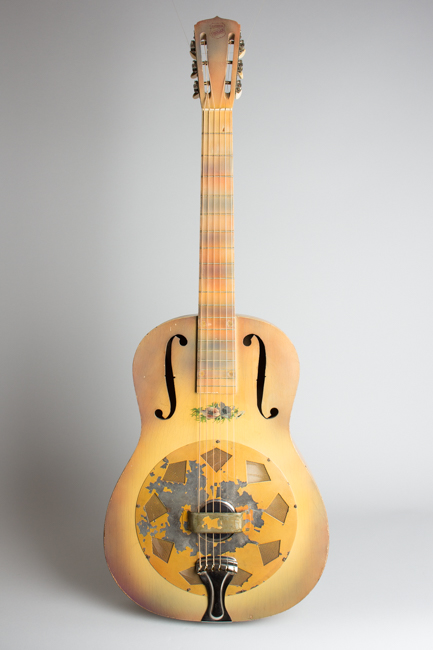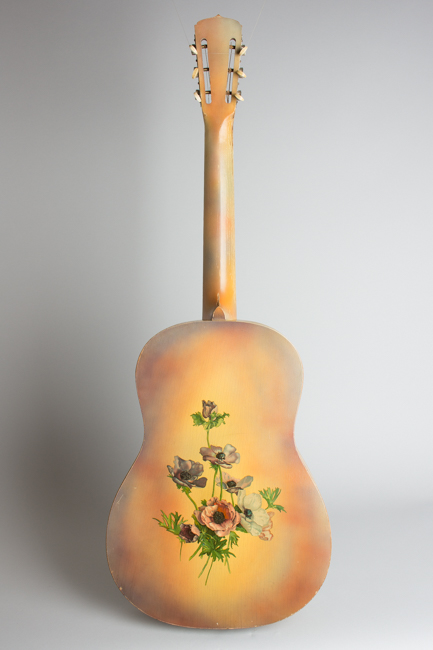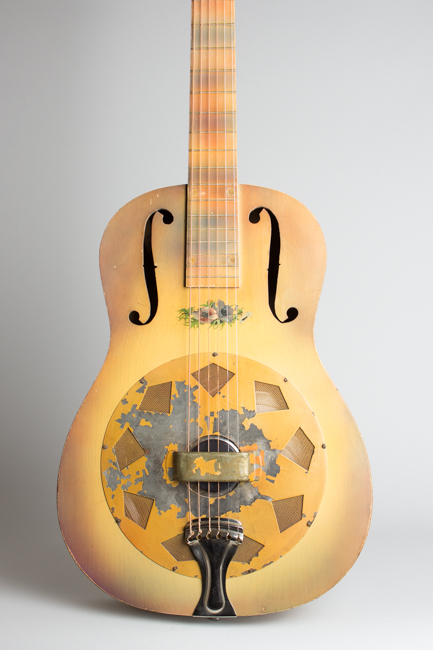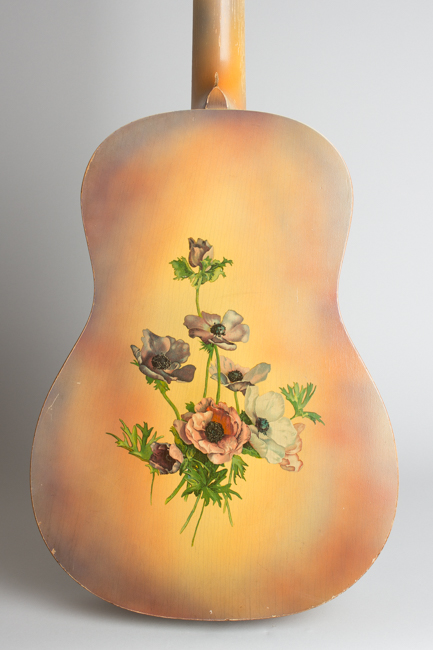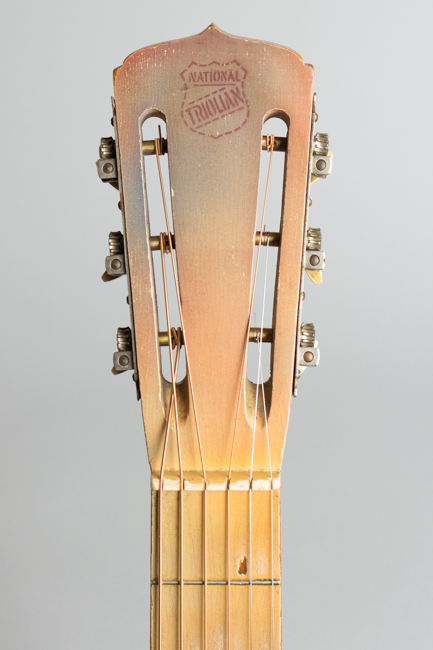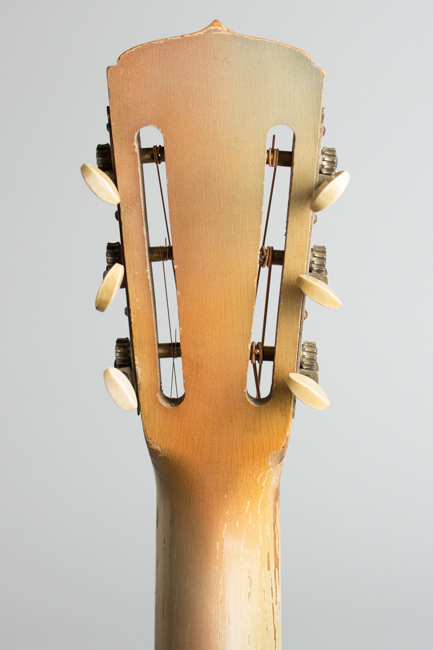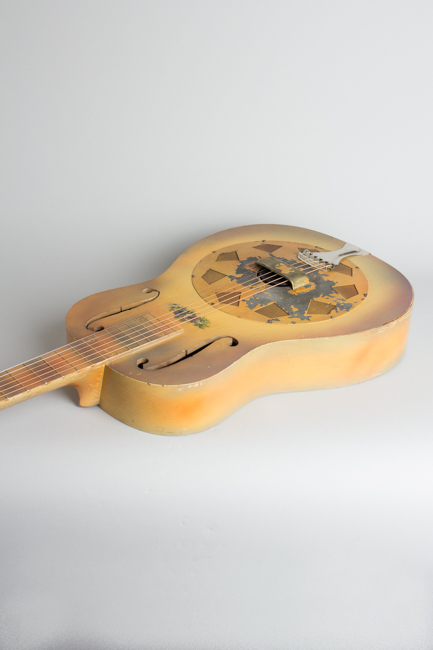National Triolian Resophonic Guitar (1928)
This item has been sold.
Item # 8275
Prices subject to change without notice.
National Triolian Model Resophonic Guitar (1928), made in Los Angeles, California, Polychrome lacquer with decals finish, laminated wood body, basswood neck, black hard shell case.
This fascinating guitar is one of the VERY earliest National single-cone guitars made, from the first production batch of the then-new Triolian model. With a screen-hole cover plate and flower bouquet decals on the body, this is the guitar identified as the progenitor of ALL subsequent National single-cone instruments.
The "Triolian" was designed just before the Great Depression made lower-priced instruments a necessity. The first dozen or so wooden-body Triolian prototypes were set up with a simplified three-cone resonator (hence the name "Triolian") that proved uneconomical for quantity production. This first single-cone version followed immediately after and was built only in very small quantities, making it extremely rare today.
The wood-body Triolian was introduced in late 1928 and discontinued in the last quarter of 1929. The single-cone resonator had proved easier and cheaper to make, but as National was more equipped to work with metal than wood, the stamped steel body was adapted as a more efficient production expediency.
The wood-body Triolian was replaced by the much more common metal-body version, built in the thousands through the 1930s. This floral-decorated version is thought to have been built in a quantity of only several dozen, according to National historian Bob Brozman.
There are many differences between this very early Triolian and even later wood-body models. This guitar's twelve-fret basswood neck has an unbound, painted fingerboard. The laminated wooden body is painted pale yellow with very subtle airbrushed highlights. There is a beautiful full-color stencil of a stand of anemone flowers on the back and a small floral bouquet on front, both unique to this first variant -- it was quickly replaced with the more familiar "Hula Girl" decoration.
The tuners are the same fairly fancy engraved-plate Waverly strips used on the Tricones of the period, and the headstock has the same peaked shape to the upper edge. The "National Triolian" logo on the headstock is a plain stencil. While most wood-body Triolians have the words "PAT APP FOR" stamped directly on top between the fingerboard just above resonator cover, this one does not.
The single-cone guitars that descended from this first model ensured the National company's survival during the Depression, being far less expensive to produce than the elaborate Tricone that had previously been their sole product. This first style Triolian is historically significant, representative of both the earliest commercial single-cone guitar and the first wooden-body resonator instrument. It is also a wonderful-sounding guitar, with a deep and surprisingly sweet tone quite unlike its steel-bodied brothers, in both feel and tone.
Overall length is 38 1/2 in. (97.8 cm.), 14 in. (35.6 cm.) wide at lower bout, and 3 1/2 in. (8.9 cm.) in depth at side, taken at the end block. Scale length is 25 in. (635 mm.). Width of nut is 1 3/4 in. (44 mm.).
This Triolian has had a recent neck set and is in fine-playing condition; the cone and biscuit are new, but everything else is original. The finish on the steel coverplate and handrest has flaked off quite a bit of the metal surface, as is unfortunately common with these early models. The body and neck finish shows some checking and flaking (mostly on the back of the neck), but overall is better-preserved than many. The flower decals and headstock stencil are also in excellent shape.
The finish patching to the fingerboard over the body is a bit sloppy and there are small wear spots in the first position, but the overall look of the board finish is much better than most, and the frets show minimal wear. This is a very nice-playing example of this extremely rare and rather historic National, and it sounds lovely as well. Overall Very Good + Condition.
This fascinating guitar is one of the VERY earliest National single-cone guitars made, from the first production batch of the then-new Triolian model. With a screen-hole cover plate and flower bouquet decals on the body, this is the guitar identified as the progenitor of ALL subsequent National single-cone instruments.
The "Triolian" was designed just before the Great Depression made lower-priced instruments a necessity. The first dozen or so wooden-body Triolian prototypes were set up with a simplified three-cone resonator (hence the name "Triolian") that proved uneconomical for quantity production. This first single-cone version followed immediately after and was built only in very small quantities, making it extremely rare today.
The wood-body Triolian was introduced in late 1928 and discontinued in the last quarter of 1929. The single-cone resonator had proved easier and cheaper to make, but as National was more equipped to work with metal than wood, the stamped steel body was adapted as a more efficient production expediency.
The wood-body Triolian was replaced by the much more common metal-body version, built in the thousands through the 1930s. This floral-decorated version is thought to have been built in a quantity of only several dozen, according to National historian Bob Brozman.
There are many differences between this very early Triolian and even later wood-body models. This guitar's twelve-fret basswood neck has an unbound, painted fingerboard. The laminated wooden body is painted pale yellow with very subtle airbrushed highlights. There is a beautiful full-color stencil of a stand of anemone flowers on the back and a small floral bouquet on front, both unique to this first variant -- it was quickly replaced with the more familiar "Hula Girl" decoration.
The tuners are the same fairly fancy engraved-plate Waverly strips used on the Tricones of the period, and the headstock has the same peaked shape to the upper edge. The "National Triolian" logo on the headstock is a plain stencil. While most wood-body Triolians have the words "PAT APP FOR" stamped directly on top between the fingerboard just above resonator cover, this one does not.
The single-cone guitars that descended from this first model ensured the National company's survival during the Depression, being far less expensive to produce than the elaborate Tricone that had previously been their sole product. This first style Triolian is historically significant, representative of both the earliest commercial single-cone guitar and the first wooden-body resonator instrument. It is also a wonderful-sounding guitar, with a deep and surprisingly sweet tone quite unlike its steel-bodied brothers, in both feel and tone.
Overall length is 38 1/2 in. (97.8 cm.), 14 in. (35.6 cm.) wide at lower bout, and 3 1/2 in. (8.9 cm.) in depth at side, taken at the end block. Scale length is 25 in. (635 mm.). Width of nut is 1 3/4 in. (44 mm.).
This Triolian has had a recent neck set and is in fine-playing condition; the cone and biscuit are new, but everything else is original. The finish on the steel coverplate and handrest has flaked off quite a bit of the metal surface, as is unfortunately common with these early models. The body and neck finish shows some checking and flaking (mostly on the back of the neck), but overall is better-preserved than many. The flower decals and headstock stencil are also in excellent shape.
The finish patching to the fingerboard over the body is a bit sloppy and there are small wear spots in the first position, but the overall look of the board finish is much better than most, and the frets show minimal wear. This is a very nice-playing example of this extremely rare and rather historic National, and it sounds lovely as well. Overall Very Good + Condition.
